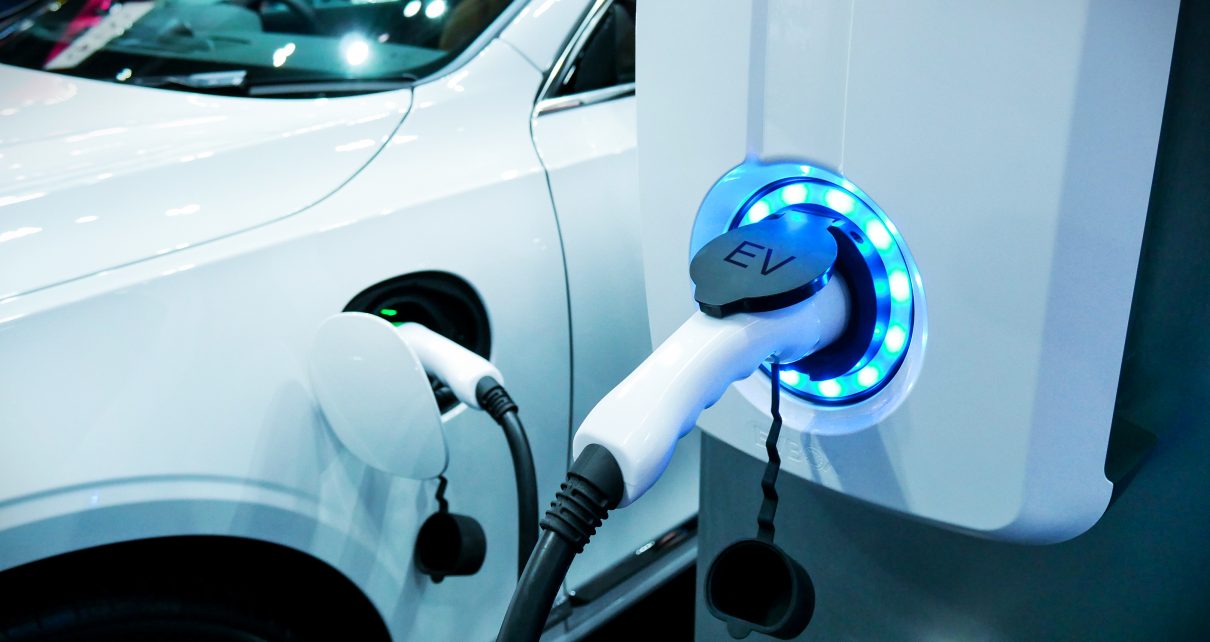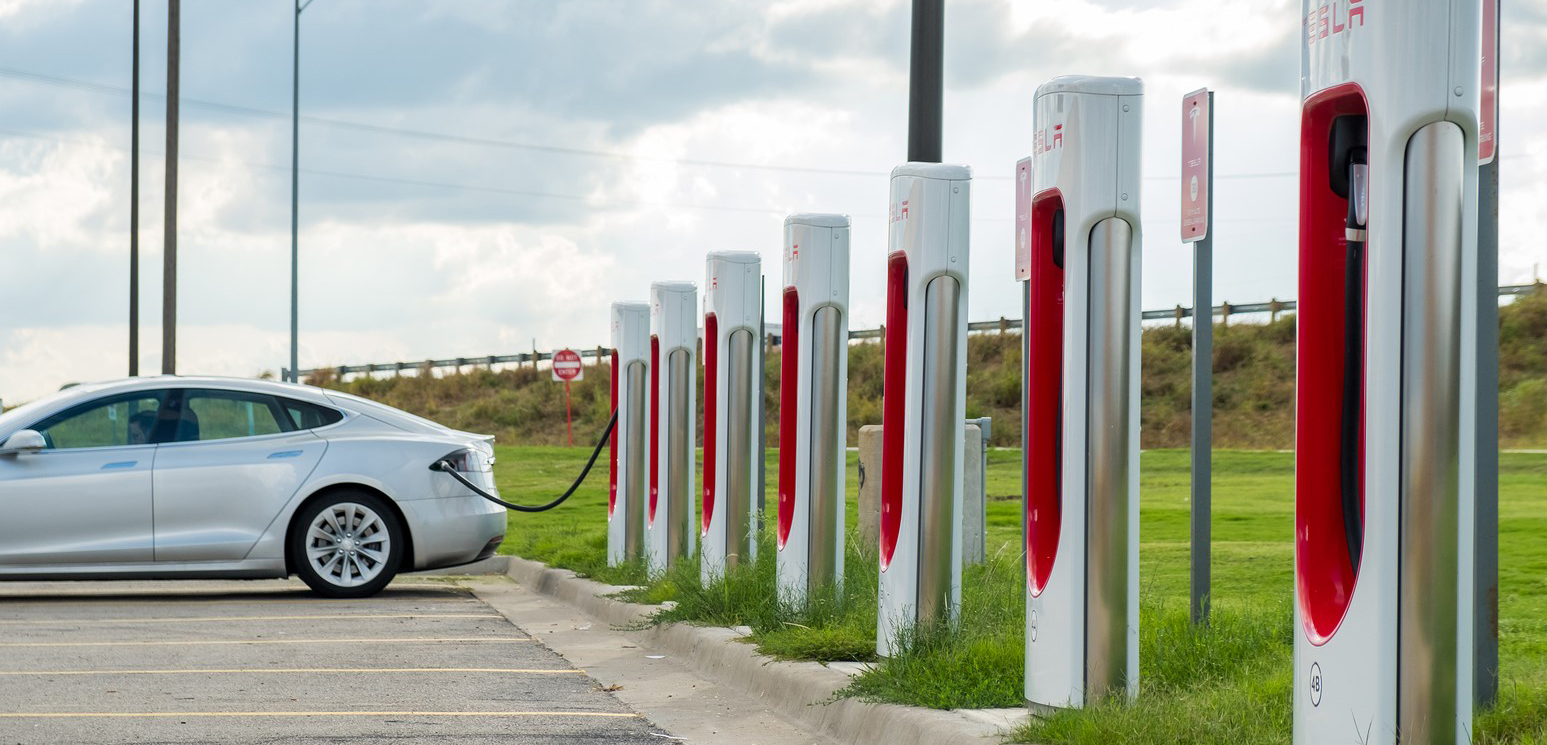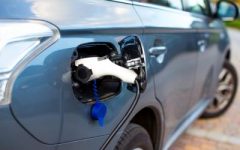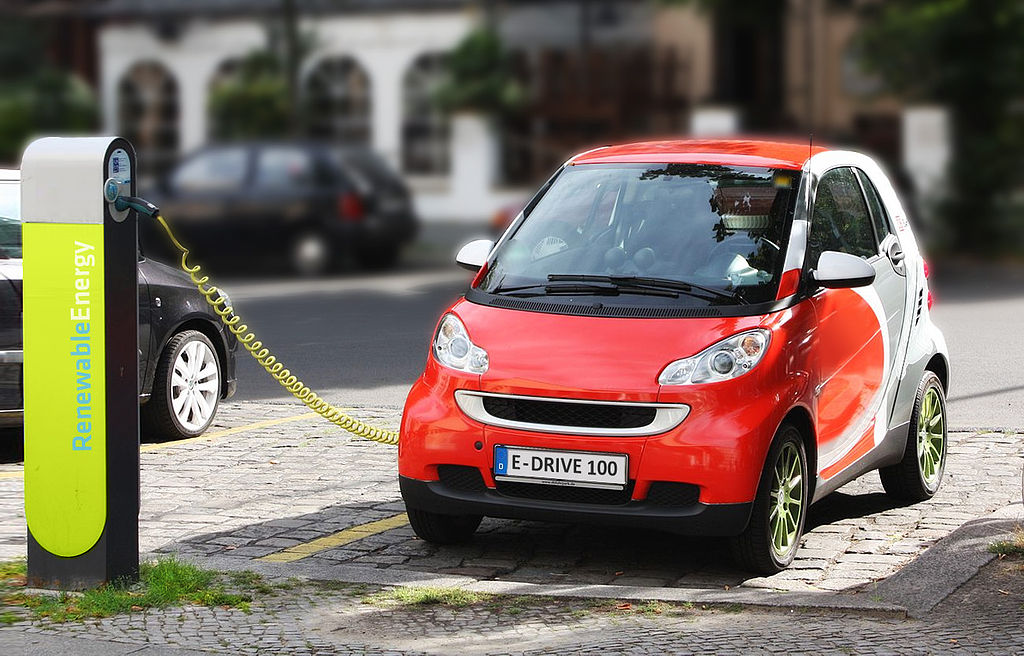
A power supply charging the battery of an electric automobile. (Photo: Shutterstock/buffaloboy)
Is the Electric Car Market Collapsing or Cooling?
‘Other reasons beyond price tarnish the EV spit shine, blinding many EV drum beaters’
By Katy Grimes, February 3, 2024 10:00 am
The electric car market is cooling – in fact, many say it is downright chilly.
“Electric vehicle sales have hit a tipping point,” Yahoo Finance reports. “Research firm Kelley Blue Book (KBB) finds that US EV sales in the third quarter crossed 313,000, nearly a 50% increase from a year ago, with EV market share hitting 7.9% — its highest-ever level. But this milestone might not be good enough for automakers spending billions on an EV transformation.”
EVs are much more expensive, costing significantly more to own than a hybrid, require electric charging, have range limitations, and require electricity to charge on an already taxed electric al grid – whereas hybrid vehicles reduce the use of fossil fuels while lowering emissions in the short term.
Ford and even Tesla are dialing back EVs. “GM is scrapping its target of producing about half a million new EVs by the middle of next year, Ford extended its timeline to hit a goal of 600,000 EVs a year, and even Tesla sees demand softening.”
Because of the expense, and charging issues, electric cars have become a harder sell. “If it doesn’t have a motor, it’s going to be a problem,” a car expert told the Globe. “That’s what makes hydrogen such a viable source – no batteries.” (That’s another article at another day…)
Last week, Hertz Car Rental company announced that it plans to sell off 20,000 of its electric vehicles, including Teslas, write off a $245 million loss, and buy more gas-powered vehicles. It seems that travelers aren’t crazy about electric car rentals. A friend reported when he and his wife traveled to Hawaii for vacation, the car rental agency only had electric cars available. Begrudgingly they accepted one. However, they were never able to find a charging station and quickly returned the car to Hertz. The car rental agency acknowledged there were no charging stations on the island except at the rental car location.
This is what forced consumption of a product by government looks like.
Buick
General Motors announced in late December that nearly half its Buick dealers opted for buyouts rather than invest in selling and servicing electric vehicles as the automaker’s brands transition to all electric by 2030, Detroit Free Press reported in December.
“That means GM will end 2023 with about 1,000 Buick stores nationwide, down 47% from where it started the year. Late last year, Buick said it would be asking dealers to commit a minimum investment of $300,000 to $400,000 to prepare their stores to sell and service EVs.”
The issue was that Buick expected its dealers to commit a minimum investment of $300,000 to $400,000 to prepare their stores to sell and service EVs. Instead more than half of the dealers said no.
Ford
50 Percent Of Ford Dealers Opt Out Of EV Sales For 2024, read the headline by Ford Authority in December. “Since it announced the Model e Certified program last year, Ford has dealt with its fair share of backlash related to this new EV sales program, which Ford dealers were given the chance to either opt in or out of.”
“According to FoMoCo, around 1,550 Ford dealers in the U.S. – around half – have chosen to opt out of the EV sales program in the coming year, compared to the 1,920 dealers that opted in roughly one year ago.”
With the high number of Ford dealers deciding to opt out of the EV market, Ford is dialing back planned EV investments.
Volvo
Volvo (owned by China’s Zhejiang Geely Holding Group) pulled the plug on its electric vehicles. “Volvo has announced that it will no longer fund Polestar, although the two brands will continue to collaborate on manufacturing and R&D,” Car and Driver reported Thursday. “Volvo and Polestar are breaking up—financially speaking, that is. The news comes after Volvo announced it will no longer fund Polestar, which features a slowly expanding all-electric lineup. Instead, Geely, the Chinese automotive giant that owns both brands, will now provide full financial and operational support to Polestar going forward.”
Car and Driver tells us more about the Polestar and Volvo EV market:
“While Volvo won’t be giving Polestar money anymore, the two will continue to collaborate on activities including manufacturing and R&D. Of course, Volvo also has the benefit of selling cars and SUVs with internal-combustion engines along with its upcoming EVs such as the EX30 and EX90.
Meanwhile, Polestar exclusively sells EVs, which are currently seeing a decline in sales around the globe. Being an all-electric brand with a tiny lineup (right now, the Polestar 2 is the only model sold in the U.S.) as well as a slow rollout of new models has caused the company to struggle.”
Electric vehicles versus hybrids
Kelly Blue Book did a thorough analysis of Hybrid vs. Electric Cars, and concluded that Hybrids make more sense. “Although EVs may well be the long-term solution, it seems they could be a short-term disaster,” they report. “Based on current realities, hybrid vehicles reduce the use of fossil fuels while lowering emissions in the short term.”
They offer pros and cons of hybrids and EVs, and conclude that EVs are NOT the most sensible tool for reducing fossil fuel usage while cutting harmful emissions. “Rushing headlong into force-feeding EVs to the public invites short-term disaster.”
Kelly Blue Book reports on the 5-year cost to own projections.
Do Electric Vehicles Cost Less to Own?
“This is one of the biggest misconceptions about fully electric vehicles. No, they don’t cost less to own in the first five years. It costs more to own an EV than a hybrid in that timeframe, even if some or all of an EV’s inflated price difference is negated with a government tax credit or a rebate.”
Kelley Blue Book’s 5-Year Cost-to-Own Projections
| 2023 Kia Niro Hybrid | 2023 Kia Niro EV | |
| Depreciation | $17,233 | $32,026 |
| Fuel | $4,714 | $3,771 |
| Insurance | $5,107 | $5,399 |
| State Fees | $3,127 | $4,000 |
| Financing | $4,359 | $5,758 |
| Maintenance | $4,082 | $3,018 |
| Repairs | $686 | $686 |
| Total 5-Year Cost-to-Own | $39,308 | $54,658 |
“Yes. That’s a 5-year cost-to-own difference of $15,350,” KBB reports. “Therefore, even if the Kia Niro electric car qualified for the maximum federal tax credit of $7,500, which it doesn’t because it’s built in South Korea, it would still cost thousands more to own.”
Just imagine what the used EV market will look like in short order.
KBB also notes that Oil is in plentiful supply. “Yet when making lithium-ion batteries, five of the metals required come from a few third-world countries with little in the way of mining regulations or oversight. Despite pushing for consumers to drive electric vehicles, environmentalists and the federal government have prevented mining precious metals in the U.S., citing environmental concerns.”
“China controls most of the world’s cobalt, another rare metal critical to lithium-ion battery production. Chinese companies own the cobalt mines, primarily in the Democratic Republic of the Congo, extract the ore there, and then ship it to China. What could go wrong?”
As Russ Heaps says at Kelly Blue Book, “a ride around the block on the reality bus makes it abundantly clear other reasons beyond price tarnish the EV spit shine, blinding many EV drum beaters.”





Just one more example that the Green agenda is really meant to enslave us and make us totally dependent on government. Fortunately, the folks have “woke” up and are standing up against this nonsense. If a person wants an EV I have no issue with that personal choice. The key phrase is personal choice and not a mandated choice which is where we are heading.
AMEN!!!
Reality finally caught up to the lies told by the EV cultists and NWO despots. Everyone who had more than two brain cells to rub together knew this day was coming but government payouts kept the party going until it collapsed under the weight of FACTS.
I wonder if we should outlaw EV’s as being bad for the environment or just allow them to go the way of other fads and just fade away into history.
Please will somebody tell that jackass governor of ours!
Mr. Climate change mandating EVs by 20??.
Then his PUC pulls the rug out from under those selling their power back to PGE.
A complete jackass this man.
I want to share an anecdote because this really happened to someone. One of MotorTrend’s writers, Christian Seabaugh (big, big fan of electric vehicles), and his family gave the F-150 Lightning EV truck a try as they were having a health emergency in Sacramento on a Labor Day afternoon last year. From beginning to end, everything looks irritating and a big hassle. First, Ford has an app that he had to spend 20 minutes plotting his route so he could find the proper charging station(s) for his EV truck. Otherwise, he would’ve spent 40 minutes just trying to find the proper charging station(s). So that was his choice: either waste 40 mins looking for a charging station or spend 20 mins planning to find a charging station on the app. This was a simple trip, mostly up Interstate 5, from Los Angeles to Sacramento. One of the annoying things he found out was that he could go up to 70 mph and still get a good range. Anything past 70 mph, the mile range drops. Now, 70 mph is not that fast. I was driving on Interstate 15 to Utah on a Saturday before New Year’s Eve, and cars were travelling at 80-100 mph. Had I gone 70 mph the whole time, I would’ve been run off the road and into a ditch.
So, Christian Seabaugh and his family started with a 93% charge and he’s got a range of 287 miles, and he’s gonna stop twice along Interstate 5, and each stop was expected to be 45 minutes long. Now, right there I’m thinking that he had to waste 20 minutes on a Ford app plotting where he’s gonna stop, then make 2 stops at each charging station and charge his truck for 45 mins each. That’s 90 mins. right there for the stops plus the 20 mins. he spent staring at the app.. So, he was looking at 2 extra hours added to his 6-hour trip to Sacramento. I could pull up at a gas station and be done filling up my tank in just under 5 minutes. Now, by the time Christian got to his first stop in Harris Ranch in Coalinga, he found that there were 6 chargers, 2 of them were occupied, the third one was “offline”, the fourth one said “charger unavailable”, the fifth & sixth one appeared to be “online” but neither of them worked. By this time, he was down to a 37-mile range, he’s down to a 14% charge, and he’s got 6 charging stations in front of him but 4 of them are broken and the other 2 are occupied. So, he went back to the Ford app and found there’s another charging station on the other side of the freeway, but these are slow chargers. There’s one tower open there, but that charger was down too. So Christian went back to the first set of 6 charging stations and got in line behind the BMW and had to wait for another 20 mins., then plugged his EV truck and it looked like he’s not gonna make it to Sacramento until 2am. He’s on this charger for 1 hour. He’s only got 2/3rds of a full charge and about 180 miles of range when he decided to get back on the road and stop at another charging station 100 miles away. Once there, Christian found a working charger but quickly realized that he and his family are gonna be so late they’re gonna have to stay overnight at a hotel. Remember, they had a health emergency situation and they had to go see their family in Sacramento ASAP, but they couldn’t get there within a day because all the chargers were either broken, occupied, or were slow to charge. So Christian and his family finally surrendered, went to a hotel, plugged their F-150 EV truck to a hotel charger so they could sleep for a few hours and then wake up with a full charge.
Now who in his/her right mind would wanna take a trip like this? Who would wanna go through this? This was just a trip going to Sacramento along the I-5. This is one of the most obvious reasons why I’m not crazy at all over these EVs.
Romeo, a little less than a year ago there was a video of two people testing the driving range difference between a GMC Hummer electric truck and a Dodge Ram 2500 diesel pickup. Both rigs were “fueled” up. Both rigs were pulling identical 7,000 pound travel trailers. They travelled together on an interstate highway east of Denver. The objective was to see how far the trucks could go pulling the same weight. The electric Hummer made it 126 miles before running out of electrons. Reasonable people can draw their own conclusions how the electric pickup would work in the real world.
I don’t have an inherent issue with BEV’s, my wife has a model 3 and its great for her use case and running errands around town is the best. My issue lies with the mandate. It’s not allowing for the OEM’s to dabble in alternative technologies with the most obvious being hybrids. Government meddling in the free market has unintended (but entirely predictable) consequences, and in this case, a massive financial liability for the OEM’s forced to create unprofitable and undesirable vehicles. This is not sustainable.
By the way, once/if you get a BEV, you’ll quickly lose range anxiety, at least here in CA as the charging infrastructure is fairly robust. The real issue with BEV ownership is rapid loss of resale value. Used BEV’s are just like an older cell phones; outdated technology with a battery of reduced capacity. I get being an early adopter has its costs, but I don’t see any improvement in this reality any time soon.
“Range anxiety” is not why am loathe to waste money on a BEV, it’s because I have a degree in mechanical engineering and know better. Five minutes at a gas station and I’m done, versus the inefficiency of waiting at a charging station.
It doesn’t take an advanced degree to understand the drawbacks to a BEV. I think we’ve used a super charger 10-15 times in 3 years, but maybe 1-2 times did we just sit there without shopping, eating lunch, etc. Otherwise we charge at home 20% of the time, at work 75% of the time. Like I said, hate the depreciation and mandates, but having a BEV as one option in a larger ICE stable can make sense for some. And its not going to get any cheaper to operate a BEV than right now.
One thing forgotten – in the article – the weather being too hot, too cold. Narrows the use cases for EVs and limits geographic use.
One observation, I can driver up and down the hill, 3.5 miles, and I can see10-15 Teslas. Last time I was in Nevada and Utah – I could go a week and see only 5 in a week.
Katy, congratulations on another very well written article. The quality of this article is something I would expect in an automotive publication, of which I read many.